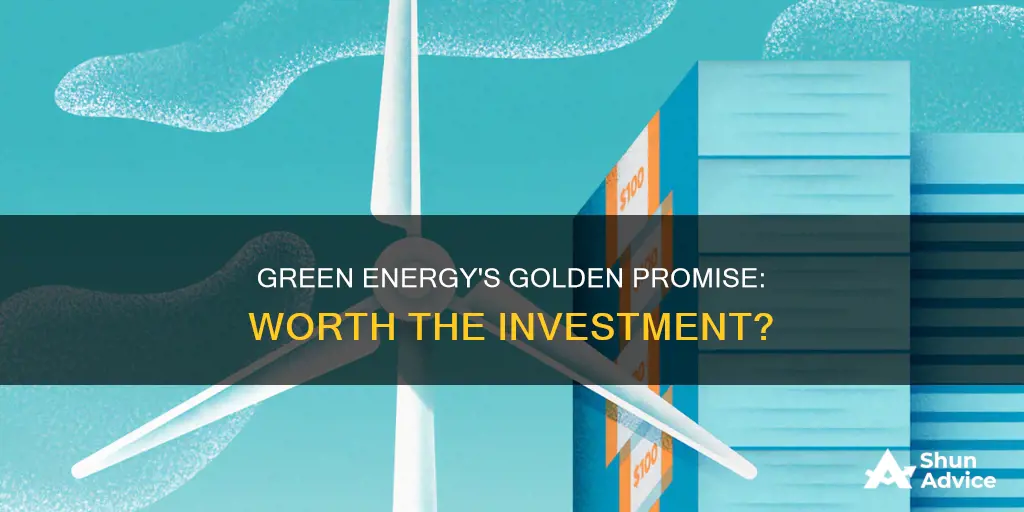
Green energy investments are becoming increasingly popular as the world transitions away from fossil fuels. With the threat of climate change looming, many nations are seeking ways to replace fossil fuels with renewable sources of energy, creating market opportunities for investors.
Global investment in transitional technologies reached $1.8 trillion in 2023, and it is expected to increase even further in the coming years. Wind, solar, and hydropower are some of the promising technologies in the green energy market.
Investing in renewable energy projects not only contributes to reducing carbon emissions but also offers financial returns. Green energy investments can generate economic returns 3 to 8 times higher than the initial investment. Additionally, these investments can drive energy independence, create new revenue streams, and make renewable energy more accessible.
While there are risks and uncertainties associated with any investment, the growing momentum towards a greener future and the potential for both financial and environmental gains make green energy investments an attractive option for those looking to make a positive impact while also seeking potential profits.
What You'll Learn
- Green energy investments can generate high returns
- Green energy investments can have a positive impact on society and the environment
- Green energy investments can be made through mutual funds or index funds
- Green energy investments can be a hedge against climate change-related news
- Green energy investments can help create new revenue streams and drive energy independence

Green energy investments can generate high returns
As the world transitions away from fossil fuels, green energy investments are becoming increasingly attractive. With the threat of climate change looming, many nations are seeking ways to replace fossil fuels with renewable sources of energy, creating a market opportunity for investors.
Market Opportunity for Investors
The demand for green energy solutions is expected to grow significantly in the coming years, driven by the need to reduce carbon emissions and the increasing global energy demand. This provides investors with the potential to profit from green energy investments.
High Returns on Green Energy Investments
Reduced Risk and Volatility
Investing in renewable energy can also help diversify investment portfolios and reduce risk. When traditional energy resources like oil experience volatility, renewable investments can act as a stabilizing force.
Government Support and Incentives
Governments around the world are also providing incentives for green energy investments. For example, feed-in tariffs in Europe guarantee investors a decent return on their investments in renewable energy. Additionally, government support facilitates a socially just and economically sound transformation towards renewable energy.
Long-Term Benefits
Green energy investments offer long-term benefits, such as creating new revenue streams, driving energy independence, and making renewable energy more accessible. They also have the potential to create more jobs and make countries energy independent, reducing the need for dirty oil wars.
Retirement Planning: 401(k) Investors Count
You may want to see also

Green energy investments can have a positive impact on society and the environment
The shift towards renewable energy is gaining momentum, with global investment in transitional technologies reaching $1.8 trillion in 2023. This trend is driven by the increasing global energy demand and the need to replace fossil fuels. Climate change models predict a temperature rise of up to 5.7 degrees Celsius by the end of the century, underscoring the urgency of transitioning to clean energy sources.
Green energy investments offer both financial and societal benefits. From a financial perspective, renewable power has delivered significant returns, with advanced economies seeing a 10-year total return of 727% on renewable energy investments. This outperforms the returns of emerging markets and developing countries, which still achieved a respectable 136% return.
The environmental benefits of green energy investments are also significant. By reducing our reliance on fossil fuels, we can decrease carbon emissions and mitigate the worst effects of climate change. Additionally, green energy investments can drive energy independence, create new revenue streams, and make renewable energy more accessible and affordable.
Furthermore, green energy investments can have a positive impact on society by creating new jobs and reducing the need for dirty oil wars. The development of renewable energy sources can also lead to improvements in energy efficiency and a reduction in energy costs for low-income families and cash-strapped companies.
In conclusion, green energy investments offer a unique opportunity to address pressing environmental concerns while also generating financial returns. By investing in renewable energy sources, we can create a more sustainable future for ourselves and future generations.
Goldman Sachs' Global Pay: The USD Advantage
You may want to see also

Green energy investments can be made through mutual funds or index funds
Green energy investments can be an excellent way to profit from the growing market opportunity presented by the global transition away from fossil fuels. As the world increasingly adopts renewable energy sources, investors can benefit from investing in companies that are driving this transition.
One way to gain exposure to the green energy sector is through mutual funds or index funds that focus on clean and renewable energy companies. These funds offer a diversified approach to investing in the long-term trend towards a more sustainable future. By investing in a basket of green energy securities, mutual funds and index funds provide a convenient and less risky way to invest in this emerging industry.
There are several mutual funds and index funds that specifically target the clean energy space. Here are some examples:
- Invesco WilderHill Clean Energy ETF (PBW): This fund tracks around 70 green energy firms, including Canadian Solar Inc. and First Solar, Inc. While it has had a negative 10-year return, it is a long-term play that could see higher returns in the future.
- IShares Global Clean Energy (ICLN): With over $2 billion in assets, ICLN is one of the largest and most established clean energy funds. It takes a diversified approach by investing in 100 stocks across solar, wind, and utility companies with significant green power facilities.
- First Trust Nasdaq Clean Edge Green Energy Index Fund (QCLN): This fund offers a broad approach to the clean energy sector, including direct green technology companies like First Solar Inc. and more tangential companies like electric vehicle manufacturer Tesla Inc.
- Fidelity U.S. Sustainability Index Fund (FITLX): FITLX is a four-star Morningstar-rated fund that has returned 12.9% annually since its inception in 2017. It focuses on companies that run mainstream businesses in an environmentally responsible way, such as Microsoft Corp. and Mastercard Inc.
- Vanguard FTSE Social Index Fund (VFTAX): This index fund excludes "sin stocks" from fossil fuel, weapons, and tobacco companies. It has outperformed the S&P 500 this year and has seen three-year gains above the market average.
- Guinness Atkinson Alternative Energy Fund (GAAEX): This small but mighty fund has returned 114% over the last five years, significantly outperforming the S&P 500. It includes renewable power producers, chipmakers for solar panels, and EV battery manufacturers.
These funds provide investors with a range of options to align their investments with their values and support the transition to a more sustainable energy future. By investing in these funds, individuals can contribute to the reduction of CO2 emissions, drive energy independence, and make renewable energy more accessible.
Tesla Stock: Buy or Bye?
You may want to see also

Green energy investments can be a hedge against climate change-related news
Global investment in transitional technologies reached a significant amount in 2023, and it is projected to increase further in the coming years to meet net-zero carbon emissions targets. Wind, solar, and hydropower are among the promising technologies in the green energy market. However, investments in renewables need to triple in the near future to achieve carbon neutrality.
The performance of green investments during the COVID-19 pandemic provides valuable insights. During the market turmoil in March 2020, funds with higher sustainability ratings outperformed those with lower ratings. Investors stuck with funds that had strong environmental, social, and governance (ESG) credentials. This trend suggests that investors view sustainability as a necessity rather than a luxury.
The concept of sustainability has gained prominence in investment decisions, with several companies integrating ESG factors into their security selection processes. Green investing, as part of ESG, is gaining traction, and research indicates a close relationship with climate change trajectories. As climate-related news and events attract attention, consumers are more inclined to choose green products, governments are pushed to enact environmental legislation, and regulators are prompted to take action.
In light of these developments, green stocks can act as a hedge against negative headlines about climate change. Even investors sceptical of global warming will consider it a risk and seek to hold stocks that safeguard their investments from market-moving bad news. Green stocks can outperform traditional energy stocks during periods when consumers increasingly favour environmentally friendly products and services.
In conclusion, green energy investments offer a potential hedge against climate change-related news and events. As the world transitions to renewable energy, investors can profit from this shift while also contributing to the fight against climate change and promoting a more sustainable future.
Hospitals: A Healthy Investment
You may want to see also

Green energy investments can help create new revenue streams and drive energy independence
Investing in renewable energy projects not only contributes to reducing CO2 emissions but also helps create new revenue streams. Green energy creates an economic return 3 to 8 times higher than the initial investment while also reducing carbon emissions. For example, in advanced economies, renewable power delivered a 10-year total return of 727%, and a 136% return in emerging markets and developing countries. This shows that green energy investments can be highly profitable while also driving positive social and environmental changes.
Energy independence refers to a country's ability to meet its energy needs without relying on energy resources from another country. Renewable energy sources, such as solar, wind, and water, can help achieve energy independence as they don't rely on fuel and only depend on trade for the acquisition of materials and components during construction. This reduces risks associated with mining, trade, and political dependence. Additionally, renewable energy supports the transition to a low-carbon economy and society, which is crucial in addressing climate change.
Nuclear energy is also seen as a potential solution for energy independence as it is efficient, safe, and helps combat the climate crisis. Several countries and companies are investing in nuclear power research and development, making it a promising area for investors.
Overall, green energy investments offer a unique opportunity to create new revenue streams and drive energy independence. By investing in renewable energy technologies, investors can not only profit from the growing demand for green energy but also contribute to a more sustainable future.
Omaxe Chandni Chowk: Worth the Investment?
You may want to see also
Frequently asked questions
Green energy investments can generate positive, measurable social and environmental changes. They can also create an economic return 3 to 8 times higher than the initial investment whilst reducing carbon emissions.
Some examples of successful green energy investments include Brookfield Renewable Partners L.P. (BEP), Algonquin Power & Utilities Corp. (AQN), and NextEra Energy Partners, LP (NEP).
One risk of investing in green energy is that the market is still relatively new and unestablished, with unclear definitions and reporting standards. Additionally, green energy stocks may be more expensive than traditional energy stocks.
There are several ways to invest in green energy, including identifying individual companies that produce alternative energy technologies or investing in a mutual fund or index fund with a large basket of green energy securities.







